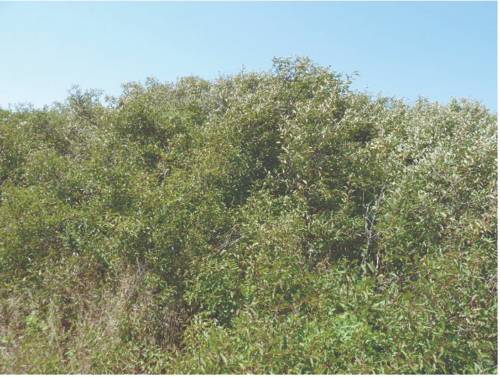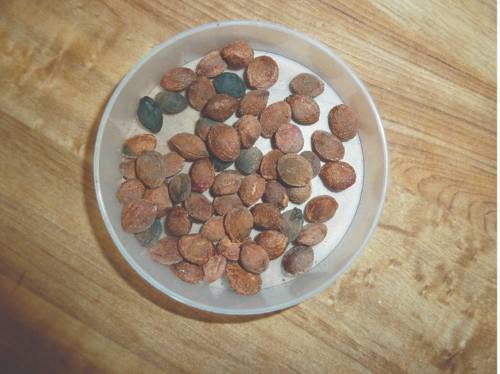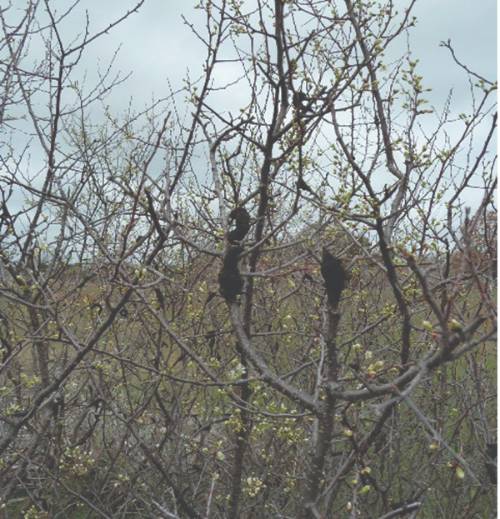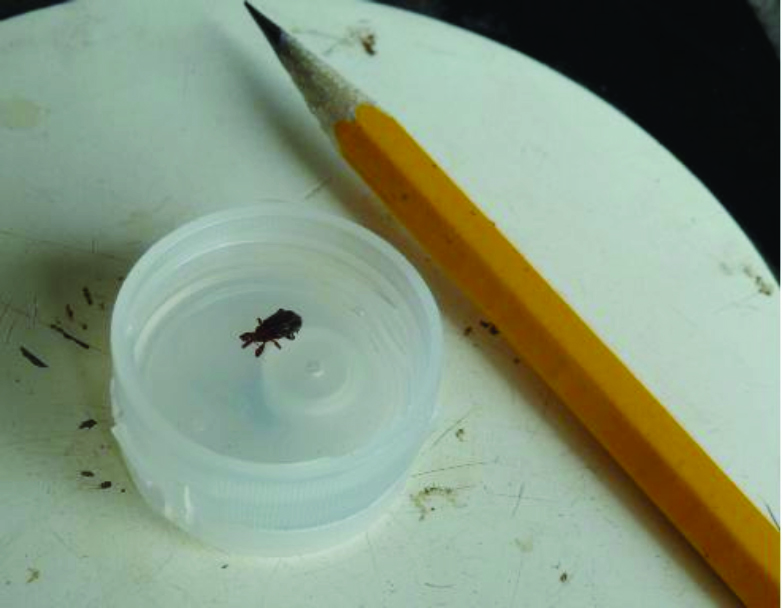Sand Plums for Home and Commercial Production
Sand plums, also known as Chickasaw plum, Cherokee plum, or Sandhill plum (Prunus angustifolia Marshall), are native fruit-producing shrubs or small trees in Oklahoma (Figure 1). Use of sand plums range from cover for native bird species to making jams, jellies, and wine from the fruit. Commercial desire in making jams and jellies has led to a rising interest in cultivating sand plums for home and orchard production. The purpose of this publication is to provide some basic knowledge on how to identify, propagate, and grow your own sand plums.

Figure 1. Clump of sand plums. These are also known as mots.
Sand plums range from 2 feet to 25 feet high, depending upon soil and water conditions (Row and Geyer, 2010). Leaves are bright green and have serrated edges that have tiny orange dots on each serration. The leaves have a slick feeling to the touch. This characteristic can help distinguish it from Oklahoma Plum (Prunus gracilis Engelm. & A. Gray), which looks very similar but has leaves that are fuzzy to the touch.
The bark is initially a deep reddish brown color that turns ash gray as the branch ages. Flowers typically appear in March to early April and are arranged in clusters. These flowers are a brilliant white and may have a faint fragrance. They usually are no bigger than 0.5 inches across (Row and Geyer, 2010). Flowering will last for a couple of weeks and either red or yellow fruit will begin to form afterward. Ripening of the fruit occurs from June to early August and are either yellow or a bright red. Both colors occur in the same areas of Oklahoma. Fruit size can range from ¼ inch to 1 inch. It is recommended that long sleeves be worn while collecting fruit since the plants may be thorny, depending upon how damaged they have been by deer and cattle in the past.
Selecting Plants
Besides selecting plants for fruit size and crop load, you may also want to consider selecting plants that have later flowering and fruiting traits. Sand plums typically begin flowering during times when they are susceptible to late frosts. Microclimate effects should be taken into consideration. Microclimates are climatic conditions that are limited to small areas. Sand plum trees may not freeze because the temperature in a microclimate is actually warmer than other areas. This effect may not be transferred when you plant the tree in a different place.
Seed Propagation
Seeds from previous year’s crops can be used to start new sand plums, provided that the seeds have not been boiled or frozen (Figure 2). Sand plum seeds require a two month cold period (stratification) to germinate. This is a simple process. To stratify the seeds, mix seeds with a moist soil media (potting soil or peat moss works fine) and place them in a sealed zip lock bag for two months at 40°F. Placing the seeds in a refrigerator will work for the cold temperature. After two months, pot up the seeds and media, so that the seeds are about a half inch below the media. Germination should occur within 14 days. Germination may continue to occur for approximately a month after the first seeds germinate. In trials at Oklahoma State University (OSU), a germination success rate that ranged from 20 percent to 44 percent. For better success, seeds should be removed from the fruit before planting. Because sand plums are generally cross pollinated, any new seedling will probably not be an exact clone of the initial parent plant.

Figure 2. Cleaned sand plum seeds.
Cuttings
Cuttings of sand plums can be used to grow a plant that is genetically the same as the one the cutting was taken from. It is highly advised to place cuttings under a mist system that mists regularly enough to keep the cuttings moist. In trials at OSU, putting a plastic bag over the cuttings stuck in moist media did not facilitate rooting.
Cuttings should be taken in the spring or early summer before it becomes too warm. Cuttings taken in the winter or without leaves may grow, but they will take longer to root and the success rate will be lower. Taking cuttings of the younger, reddish stems located at the tip of the branches is suggested. Cuttings should at least be 3 ½ inches long. Use of auxin will increase rooting success. Indolebutyric acid (IBA) is the artificial form of the plant growth hormone auxin, and is commercially available as rooting hormones, which can be purchased from your nearest garden store. Rates of 3,000 IBA and 7,000 IBA worked the best in trials. Dip the bottom ½ inch into the powder or liquid. Then stick the cuttings into media so that the bottom inch is covered.
Grafting
It may be possible to graft sand plums onto peach or plum rootstock. This is only advised if you have had practice grafting, as sand plums are difficult to graft. Success may be limited, and incompatibility may occur later in the life of the tree. For grafting, chip budding is recommended since it does not damage the rootstock as badly as T-budding. Grafting should be done when the relative humidity is high, so that the cut tissue does not dry out. Buds should be selected that are large and disease free, and should be wrapped with budding tape.
Nursery
Commercial nurseries may have sand plums for sale. Varieties of sand plums such as ‘Rainbow’ exist and are commercially available. When purchasing sand plums, make certain you are buying Prunus angustifolia.
Private Land
Sand plums can also be dug up from the side of the road. Make certain to dig deep enough to get enough of the tap root, and try not to damage the other roots. Please ask the landowner beforehand, since roadsides belong to the landowner and not the county. Another consideration is to be certain that you are digging Chickasaw plum, and not another kind of wild plum. There are over ten native plum species in Oklahoma. Plum species are known to overlap in regions, likely leading to hybrid populations which may make identification sometimes difficult. For a basic guide on identifying wild Oklahoma plums see Table 1.
Table 1. Native wild plums in Oklahoma and how to distinguish between them.
| Common Name | Scientific Name | Distinguishing Traits | |
|---|---|---|---|
| American plum | Prunus americana | short-med. height tree, slick wide leaves, hairy twigs | |
| Sand plum | Prunus angustifolia | shrub-short tree, long and slender slick leaves that fold along midrib | |
| Oklahoma plum | Prunus gracilis | shrub-short tree, fuzzy leaves with small marble size fruit | |
| Hortulan plum | Prunus hortulana | short-med. tree, Eastern Oklahoma, glossy egg shaped leaf with triangular tip | |
| Mexican plum | Prunus mexicana | short-med. tree, drooping slick wide leaves, hairless twigs | |
| Wild goose plum | Prunus munsoniana | long and slender leaf, Eastern Oklahoma. | |
| Creek plum | Prunus rivularis | short tree, long leaves with broad triangular tips. Rare in Oklahoma. | |
| Black cherry | Prunus serotina | short-med. height tree, small black fruit, wide slick leaves | |
| Chokecherry | Prunus virginiana | short-med. height tree, small dark red fruit, wide slick leaves |
Pest and Disease Problems
Sand plum trees can contract similar diseases as peaches and plums. Of these diseases, brown rot and black knot have been noted to have the most obvious effects upon wild populations.
Black Knot (Dibotryon morbosum) is a fungal disease. Though it may not be very severe, it has been observed to kill twig by twig. Selection of sand plums from a site where Black Knot is present is not advised, due to the possibility of the plant being infected by fungal spores (Figure 3).

Figure 3. Black knot fungus on a sand plum.
Brown rot (Monilia fructicola) affects sand plums as well as many other Prunus species such as peaches and apricots. In late summer, brown rot is evident on the fruit by the appearance of soft brown patches. Sometimes white specs are evident on these brown patches.
During the rest of the year, it may cause the tree to produce cankers and ooze gummy sap (Figure 4). These cankers may girdle and kill young trees. To prevent infection, select material that does not show any gummy oozing. When working with peach or plum trees, make certain to sterilize tools with 10 percent bleach before and during your work with sand plums. Keep tree wounds free and graft in only clean material to prevent the disease from occurring. Cytospora canker may also cause gummy sap to occur.

Figure 4. Gummosis on a sand plum branch.
If growing in a home or commercial setting, fruit production may be decreased by plum curculios (Conotrachelus nenuphar). This insect that attacks peach trees also attacks sand plums (Figure 5). They may burrow into the fruit, damaging it as well as leaving openings for pathogens such as brown rot. Refer to EPP-7078 “Biology and Control of the Plum Curculio in Fruit Trees in Oklahoma” for information on how to manage for plum curculios.

Figure 5. Plum curculio size compared to a pencil.
Cultural Methods
Sand plums are typically a short lived tree though some exceptions are known. Though sand plums may grow closely together in their native setting, bigger and healthier trees will result if sand plums are well spaced. No official spacing recommendation exists for sand plums, but it is advised to follow the low end of spacing recommendations provided in Oklahoma extension publication HLA-6244 “Planting and Early Care of the Peach Orchard.” Fertilization recommendations should be referred to the low end of this publication as well.
No specific pruning procedure exists for sand plums, though it is advised to prune in a way that would make the fruit most accessible to you. Overloading the tree with fruit may stress the tree, which may kill it.
Suckering on sand plums is a concern with growing the fruit. Sand plums naturally form clump, clone communities, also called mots, that are little trees that arise from the roots. Clipping suckers will not hurt the tree, and may encourage its growth, as well as prevent a mot from forming. Once sand plums are established trees, they are well-adapted to handle the heat and drought conditions often seen in Oklahoma during the summer.
Acknowledgments
Special thanks to Leon Cook, Eddy Fenton, Dr. Eric Stafne and Becky Carroll for their contributions to this publication. Pictures by Leon Cook and Beth McMahon.
Citations
Row, J. M. and W. A. Geyer. 2010. Plant Fact Sheet for Chickasaw plum (Prunus angustifolia). USDA-Natural Resources Conservation Service, Manhattan Plant Materials Center, Manhattan, KS 66502.
USDA, NRCS. 2013. The PLANTS Database (http://plants.usda.gov). National Plant Data Team, Greensboro, NC 27401-4901 USA.
Beth McMahon
Research Assistant
Oklahoma State University
Bruce Dunn
Assistant Professor
Oklahoma State University
Eric Stafne
Extension Assistant Professor
Mississippi State University
